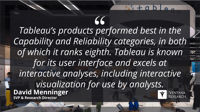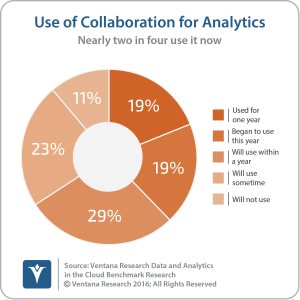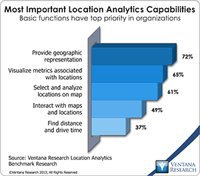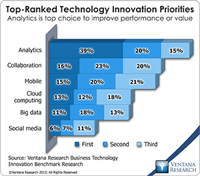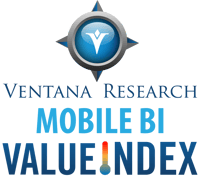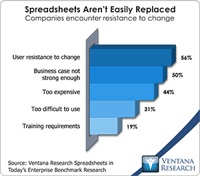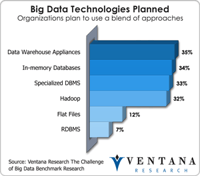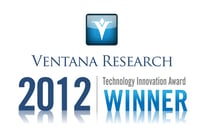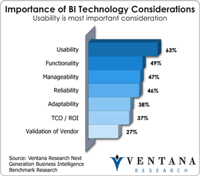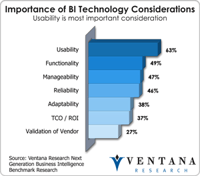I am happy to offer some insights on Tableau drawn from our latest Value Index research, which provides an analytic representation of our assessment of how well vendors’ offerings meet buyers’ requirements. TheVentana Research Value Index: Analytics and Business Intelligence 2019is the distillation of a year of market and product research efforts byVentana Research. We utilized a structured research methodology that includes evaluation categories designed to reflect the breadth of the...
Read More
Topics:
Data Science,
Tableau,
Mobile Technology,
Analytics,
Business Intelligence,
Cloud Computing,
Collaboration,
Digital Technology
More than 13,000 self-described “data and visualization nerds” gathered in Austin, TX, recently for Tableau Software’s annual customer conference. In his inaugural keynote, Tableau’s new CEO, Adam Selipsky, said that nearly 9,000 were first-time attendees. I was impressed with the enthusiasm of the customers who had gathered for the event, cheering as company officials reviewed product plans and demonstrated new features. This enthusiasm suggests Tableau has provided capabilities that resonate...
Read More
Topics:
Tableau,
Analytics,
Business Intelligence,
Visualization,
DataPrep
Tableau Software’s annual conference, which company spokespeople reported had more than 10,000 attendees, filled the MGM Grand in Las Vegas. Various product announcements supported the company’s strategy to deliver value to analysts and users of visualization tools. Advances include new data preparation and integration features, advanced analytics and mapping. The company also announced the release of a stand-alone mobile application called Vizable . One key message management aimed to promote...
Read More
Topics:
Big Data,
Tableau,
Mobile Technology,
data viz,
Operational Performance,
Analytics,
Business Analytics,
Business Intelligence,
Business Performance,
Governance, Risk & Compliance (GRC),
Information Management,
Operational Intelligence,
Visualization,
Information Optimization,
Risk & Compliance (GRC)
Qlik was an early pioneer in developing a substantial market for a visual discovery tool that enables end users to easily access and manipulate analytics and data. Its QlikView application uses an associative experience that takes an in-memory, correlation-based approach to present a simpler design and user experience for analytics than previous tools. Driven by sales of QlikView, the company’s revenue has grown to more than $.5 billion, and originating in Sweden it has a global presence.
Read More
Topics:
Big Data,
Data Visualization,
QlikView,
Sales Performance,
Supply Chain Performance,
Tableau,
Operational Performance,
Analytics,
Business Analytics,
Business Intelligence,
Business Performance,
Customer & Contact Center,
Information Applications,
Data Discovery,
Lumira,
Qlik,
Qlik Qlik Sense
Ventana Research recently completed the most comprehensive evaluation of mobile business intelligence products and vendors available anywhere today. The evaluation includes 16 technology vendors’ offerings on smartphones and tablets and use across Apple, Google Android, Microsoft Surface and RIM BlackBerry that were assessed in seven key categories: usability, manageability, reliability, capability, adaptability, vendor validation and TCO and ROI. The result is our Value Index for Mobile...
Read More
Topics:
Big Data,
MicroStrategy,
Mobile,
Mobile Business Intelligence,
Pentaho,
Sales Performance,
SAP,
SAS,
Tableau,
Jaspersoft,
Analytics,
Business Analytics,
Business Collaboration,
Business Intelligence,
Business Performance,
Customer & Contact Center,
IBM,
Information Builders,
Oracle,
Workforce Performance,
Yellowfin,
Roambi,
Value Index,
arcplan,
Logi Analytics,
Qlik
Microsoft has been steadily pouring money into big data and business intelligence. The company of course owns the most widely used analytical tool in the world, Microsoft Excel, which our benchmark research into Spreadsheets in the Enterprise shows is not going away soon. User resistance (cited by 56% of participants) and lack of a business case (50%) are the most common reasons that spreadsheets are not being replaced in the enterprise. The challenge is ensuring the spreadsheets are not just...
Read More
Topics:
Big Data,
Microsoft,
Tableau,
IT Performance,
Microsoft Office,
Microsoft Powerpoint,
Operational Performance,
Business Analytics,
Business Intelligence,
Business Performance,
CIO,
Cloud Computing,
Customer & Contact Center,
Financial Performance,
Hortonworks,
Information Applications,
Location Intelligence,
Microsoft Excel,
azure,
HDinsights
Teradata recently gave me a technology update and a peek into the future of its portfolio for big data, information management and business analytics at its annual technology influencer summit. The company continues to innovate and build upon its Teradata 14 releases and its new processing technology. Since my last analysis of Teradata’s big data strategy, it has embraced technologies like Hadoop with its Teradata Aster Appliance, which won our 2012 Technology Innovation Award in Big Data....
Read More
Topics:
Big Data,
MicroStrategy,
SAS,
Tableau,
Teradata,
Customer Excellence,
Operational Performance,
Analytics,
Business Analytics,
Business Intelligence,
CIO,
Cloud Computing,
Customer & Contact Center,
In-Memory Computing,
Information Applications,
Information Management,
Location Intelligence,
Operational Intelligence,
CMO,
Discovery,
Intelligent Memory,
Teradata Aster,
Strata+Hadoop
Our benchmark research found in business technology innovation that analytics is the most important new technology for improving their organization’s performance; they ranked big data only fifth out of six choices. This and other findings indicate that the best way for big data to contribute value to today’s organizations is to be paired with analytics. Recently, I wrote about what I call the four pillars of big data analytics on which the technology must be built. These areas are the...
Read More
Topics:
Big Data,
MicroStrategy,
Tableau,
Teradata,
alteryx,
IT Performance,
Operational Performance,
Analytics,
Business Analytics,
Business Intelligence,
Business Performance,
Customer & Contact Center,
Governance, Risk & Compliance (GRC),
IBM,
Information Applications,
Information Management,
Operational Intelligence,
Oracle
This year’s Inspire, Alteryx’s annual user conference, featured new developments around the company’s analytics platform. Alteryx CEO Dean Stoecker kicked off the event by talking about the promise of big data, the dissemination of analytics throughout the organization, and the data artisan as the “new boss.” Alteryx coined the term “data artisan” to represent the persona at the center of the company’s development and marketing efforts. My colleague Mark Smith wrote about the rise of the data...
Read More
Topics:
Predictive Analytics,
Sales Performance,
Tableau,
alteryx,
Absolute Data,
data artisan,
Operational Performance,
Analytics,
Business Analytics,
Business Intelligence,
Business Performance,
Cloud Computing,
Customer & Contact Center,
Data Integration,
Information Applications,
Operational Intelligence
SiSense gained a lot of traction last week at the Strata conference in San Jose as it broke records in the so-called 10x10x10 Challenge – analyzing 10 terabytes of data in 10 seconds on a $10,000 commodity machine – and earned the company’s Prism product the Audience Choice Award. The Israel-based company, founded in 2005, has venture capital backing and is currently running at a profit with customers in more than 50 countries and marquee customers such as Target and Merck. Prism, its primary...
Read More
Topics:
Big Data,
Sales Performance,
Tableau,
elasticube,
Operational Performance,
Analytics,
Business Intelligence,
Business Performance,
Customer & Contact Center,
Information Applications,
Information Management,
Qlik
